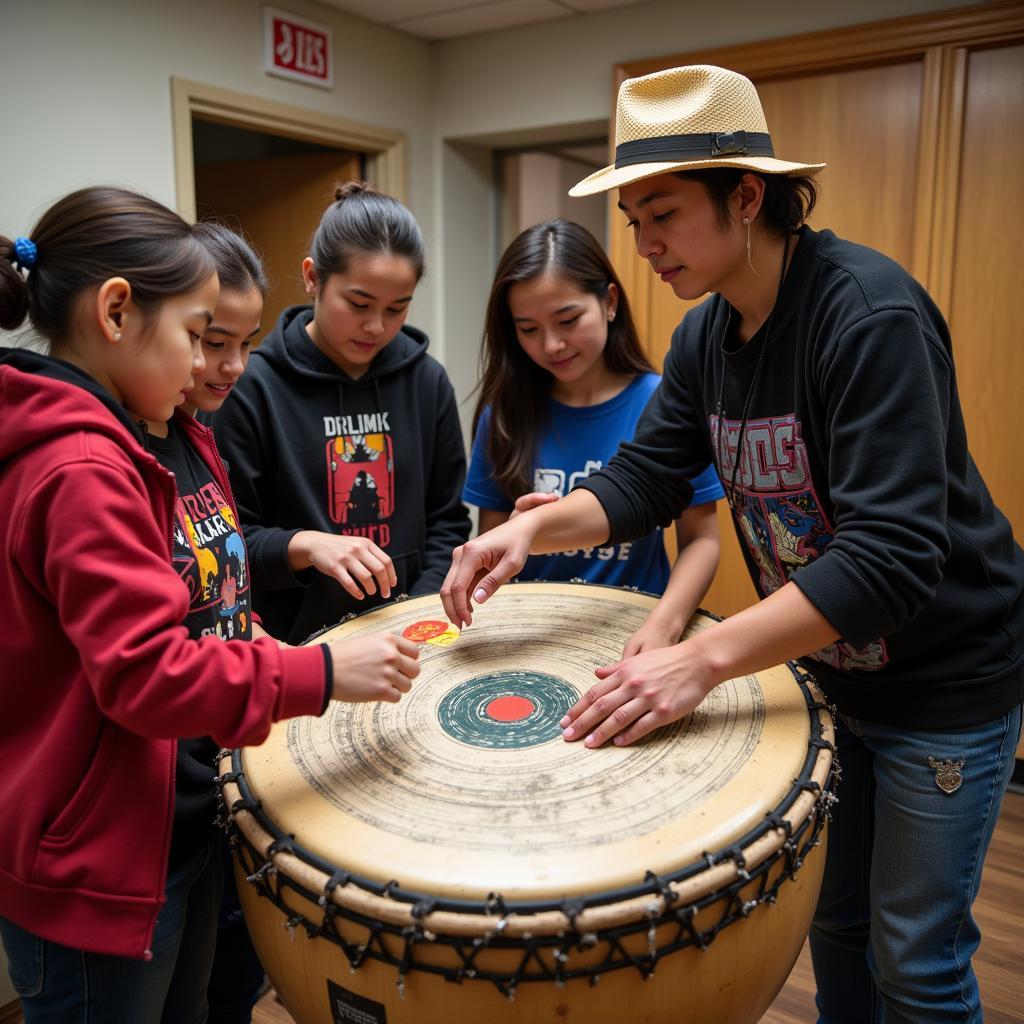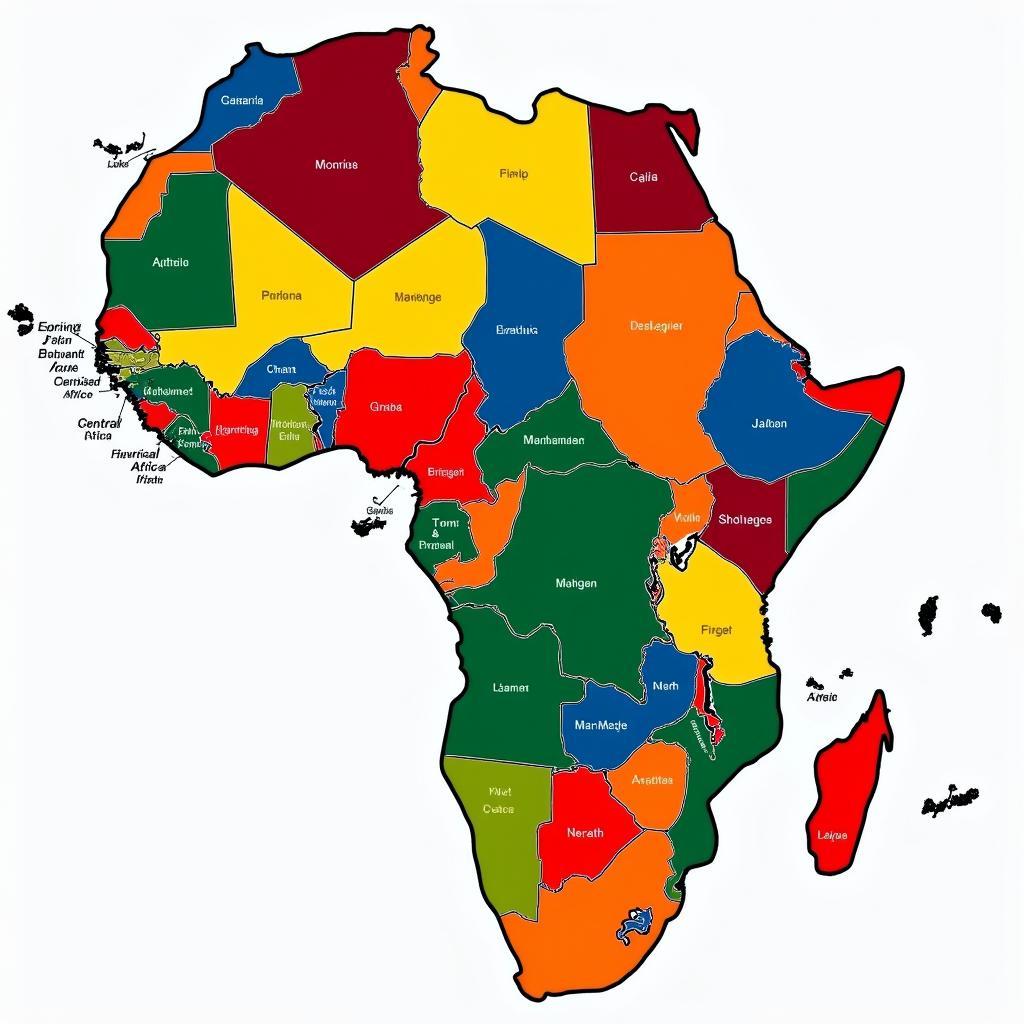Exploring the Art of African Drum Painting
African Drum Painting is a vibrant expression of culture, tradition, and artistic skill found throughout the African continent. From intricate geometric patterns to depictions of daily life and spiritual beliefs, these painted drums are more than just musical instruments; they are powerful symbols of heritage and community. This article delves into the fascinating world of African drum painting, exploring its history, techniques, symbolism, and cultural significance.
The artistry of African drum painting spans a vast array of styles, influenced by the diverse cultures and traditions across the continent. Each region, and often each tribe, has its own unique approach to decorating these instruments, using different materials, colors, and motifs. While some drums boast intricate geometric designs, others portray scenes from daily life, depict animals, or symbolize spiritual beliefs.
A Deeper Look into the History of African Drum Painting
The practice of decorating drums has deep roots in African history, dating back centuries. Drums themselves hold a significant place in many African cultures, serving not only as musical instruments but also as tools for communication, storytelling, and ritual ceremonies. African and Caribbean cultures have interacted throughout history, each having an impact on musical forms and the instruments used. The act of painting these drums elevates them to objects of art, imbuing them with deeper meaning and cultural significance. The earliest forms of drum painting likely involved natural pigments derived from plants and minerals, creating earthy tones that blended harmoniously with the natural materials used to construct the drums. Over time, the techniques and materials evolved, reflecting the changing cultural landscape and the introduction of new artistic influences. After this historical overview, you might be interested in learning more about the symbolic use of the African gourd.
Techniques and Materials Used in African Drum Painting
The techniques used in African drum painting vary depending on the region and the specific cultural traditions. Some artists use brushes made from natural fibers, while others apply paint directly with their fingers or other tools. The paints themselves can range from traditional natural pigments to modern acrylics. The preparation of the drum surface is also crucial, often involving sanding and smoothing to create a canvas for the artwork. The choice of colors also carries significance, with different colors often symbolizing specific elements, emotions, or spiritual concepts. The process of painting a drum is often a collaborative effort, involving multiple artists and community members, further strengthening the drum’s connection to the community. The result is a visually stunning and culturally rich piece of art. The African gourd has a special place in the creation of these instruments.
The Symbolic Language of African Drum Painting
The symbols and motifs used in African drum painting often hold deep cultural and spiritual meaning. Geometric patterns can represent abstract concepts like balance, harmony, and the interconnectedness of all things. Animal depictions might symbolize strength, wisdom, or protection, while scenes from daily life can capture important events or celebrate community traditions. The colors used also carry symbolic weight, with specific colors often associated with particular elements, emotions, or spiritual concepts. For example, red might symbolize power and vitality, while white can represent purity and peace. The overall design of the drum painting can tell a story, convey a message, or invoke spiritual power.
How are African Painted Drums Used?
African painted drums play a vital role in a variety of cultural and social contexts. They are central to many traditional ceremonies, including rituals, celebrations, and storytelling. The drums not only provide rhythmic accompaniment but also serve as symbolic objects, connecting communities to their ancestors and their spiritual beliefs. In some cultures, specific drums are reserved for particular ceremonies or social groups, further highlighting their cultural importance. African drum painting elevates these instruments beyond their functional role, transforming them into works of art that embody the rich cultural heritage of the communities that create them.
Preserving the Tradition of African Drum Painting
In a world of increasing globalization, preserving traditional art forms like African drum painting is essential. Many organizations and individuals are working to support African artists and ensure the continuation of these cultural practices. Efforts include workshops, exhibitions, and educational programs that promote the art form and provide opportunities for artists to share their skills with younger generations. By supporting these initiatives, we can help ensure that the vibrant tradition of African drum painting continues to thrive for generations to come. More about African dance can be found in other resources.
 Preserving African Drum Painting Traditions
Preserving African Drum Painting Traditions
Conclusion
African drum painting is a powerful expression of artistic skill, cultural heritage, and spiritual belief. From the intricate geometric patterns to the vibrant colors and symbolic motifs, these painted drums are more than just musical instruments; they are living embodiments of African culture. By understanding the history, techniques, and symbolism behind African drum painting, we gain a deeper appreciation for the rich cultural tapestry of the African continent and the enduring power of art to connect us to our shared human experience. Continue exploring the world of African art and discover its captivating beauty and meaning. You might enjoy learning more about traditional African hairstyles and adornments. Check out this resource for more: African girl kirkhi extension for fun.
african girl kirkhi extension for fun
FAQ
-
What types of paint are used in African drum painting? Traditional natural pigments as well as modern acrylics are used.
-
What do the symbols on African drums represent? They can represent abstract concepts, animals, daily life, or spiritual beliefs.
-
How are African painted drums used? They are used in ceremonies, celebrations, rituals, and storytelling.
-
Are there different styles of African drum painting? Yes, styles vary depending on the region and cultural traditions.
-
How can I support African drum artists? You can support them by purchasing their work, attending exhibitions, and supporting organizations that promote African art.
-
What is the significance of the colors used in African drum painting? Different colors often symbolize specific elements, emotions, or spiritual concepts.
-
Where can I learn more about African drum painting? Museums, cultural centers, and online resources offer further information.
Further Questions to Explore
- What are the different types of African drums used in ceremonies?
- How is drum making itself an art form in Africa?
- Are there specific rituals associated with painting drums in different African cultures?
Need help? Contact us 24/7:
Phone: +255768904061
Email: kaka.mag@gmail.com
Address: Mbarali DC Mawindi, Kangaga, Tanzania.

